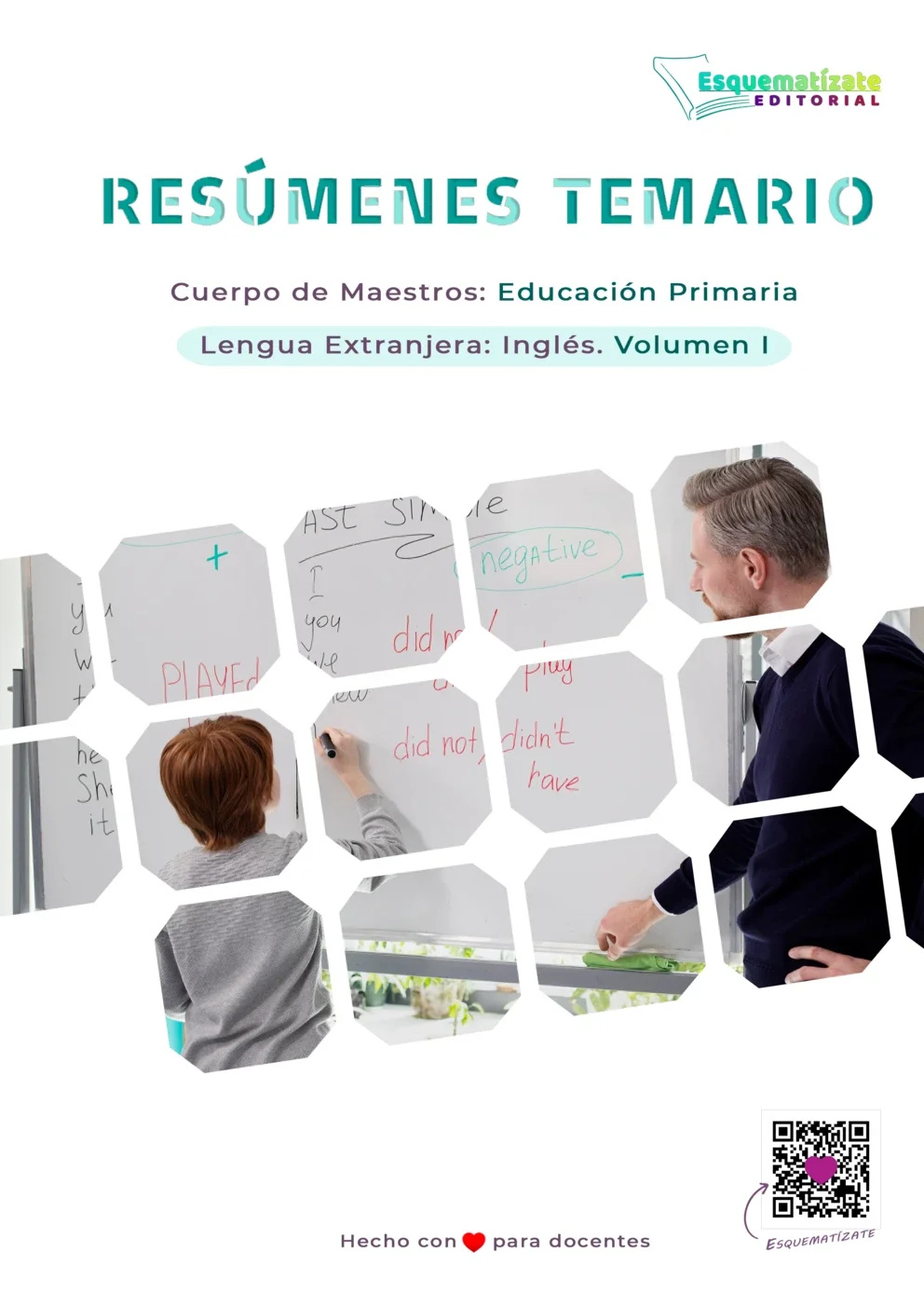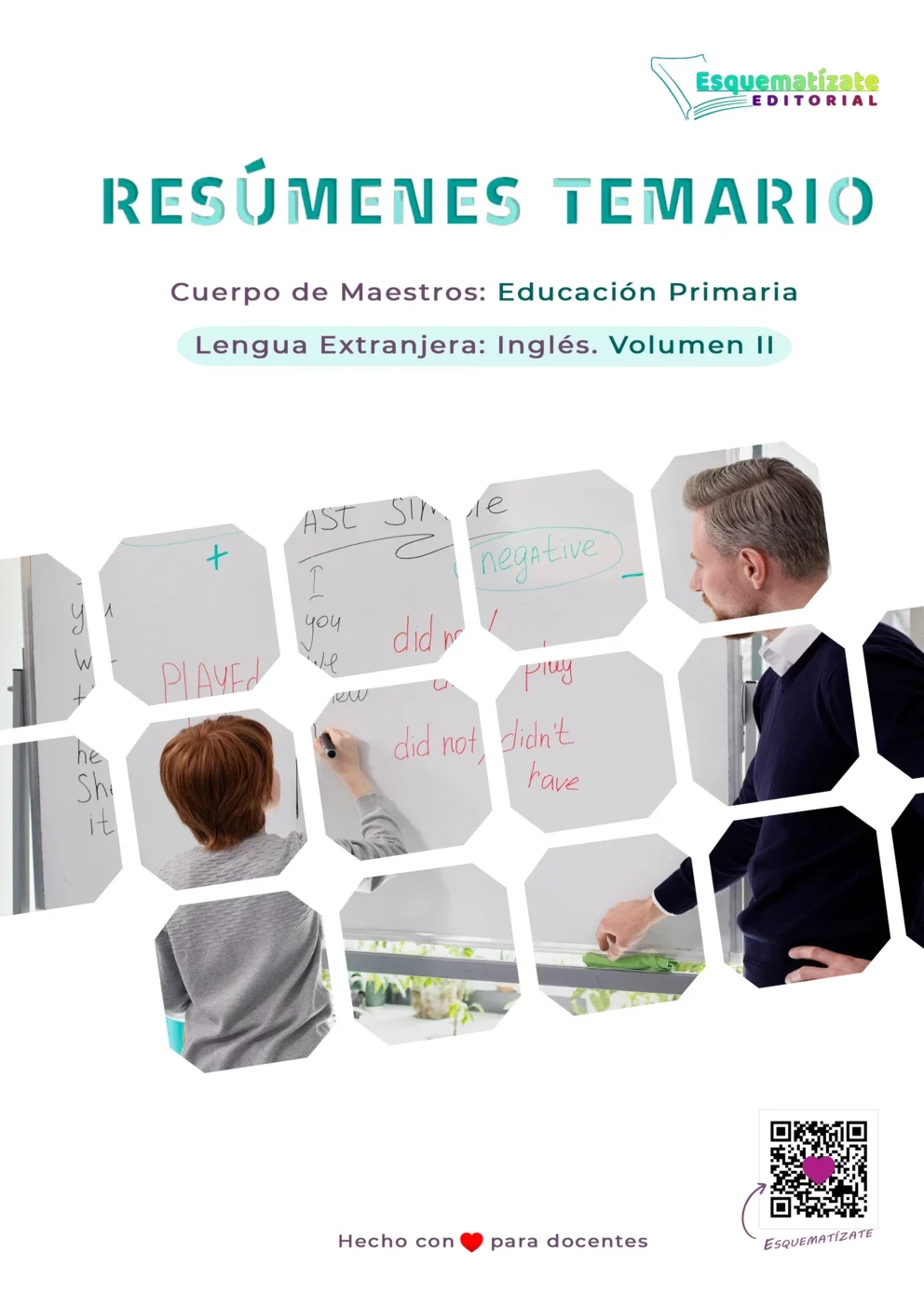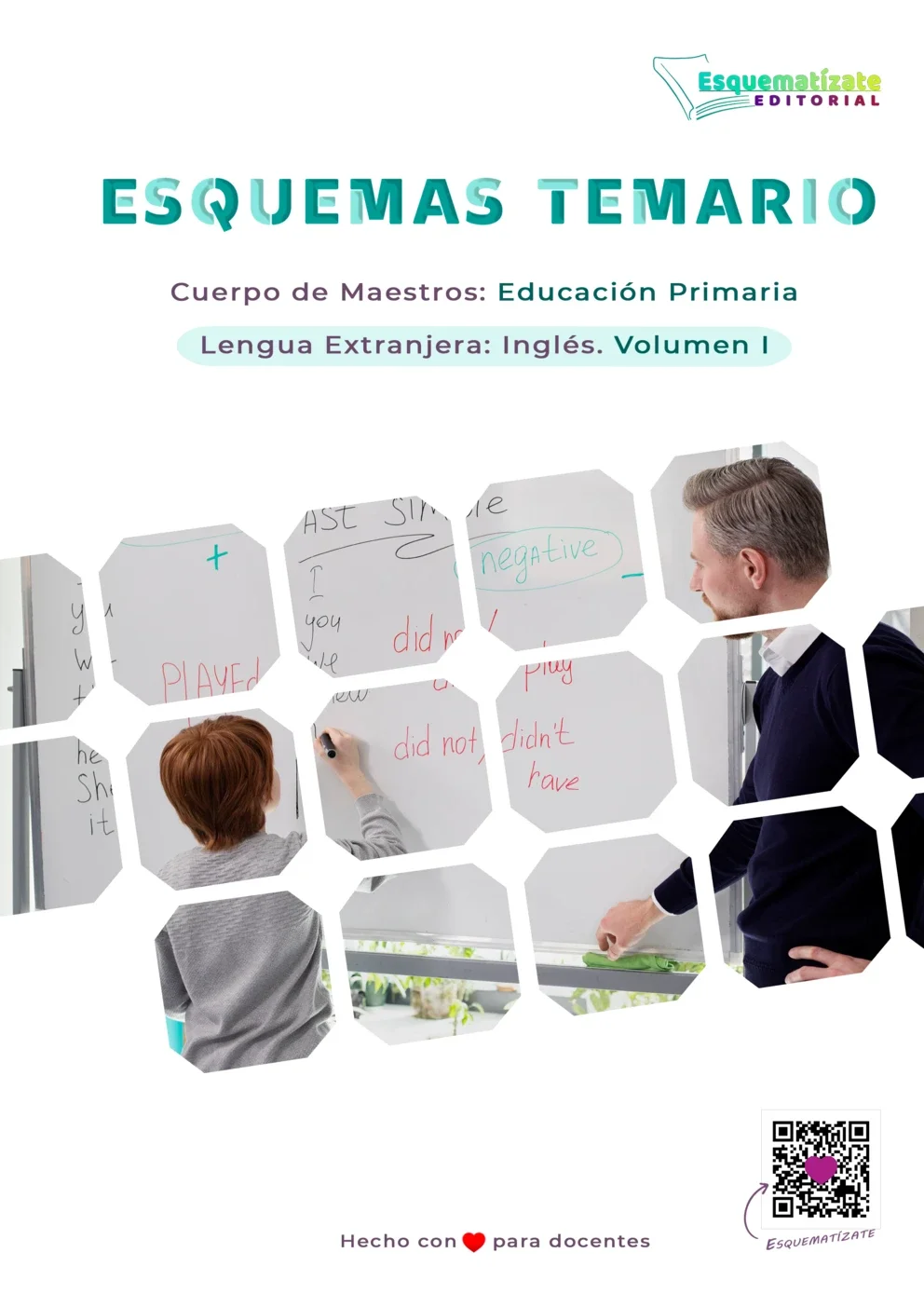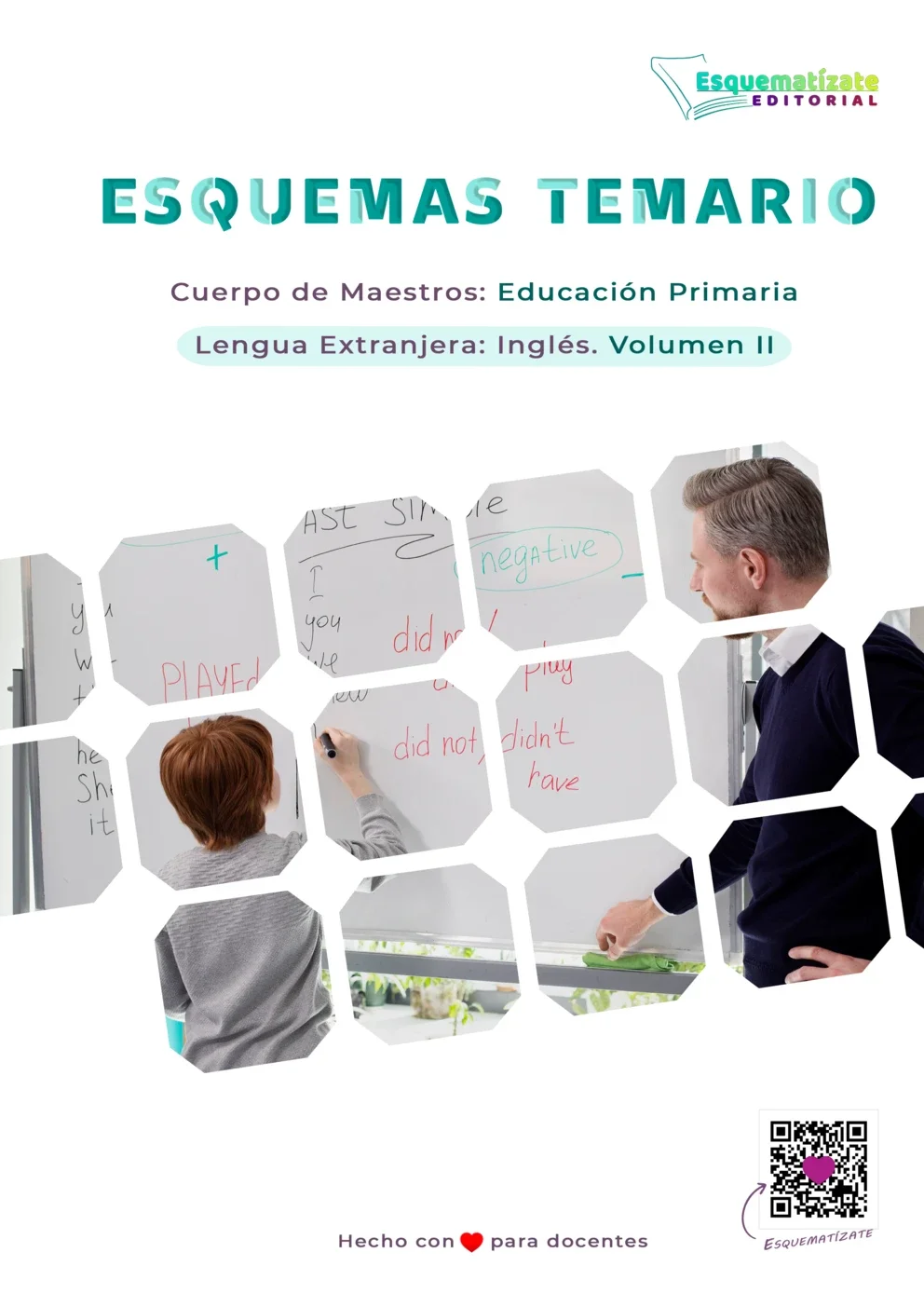Temario Lengua Extranjera inglés
¡Temario Maestro Lengua Extranjera inglés RESUMIDO PARA ESTUDIAR LO QUE ESCRIBIRÁS EN EL EXAMEN!

Fáciles de aprender

Aplicación didáctica

Profundidad científica

En base a los criterios de evaluación

Elaborados en base a la LOMLOE

Adaptados al tiempo del examen

Listos para estudiar

Libro visualmente atractivo

Haz clic para ver el temario oposiciones lengua extranjera inglés que desees
4-5 Hojas
1 Hoja vista
Temario OPOSICIONES LENGUA EXTRANJERA INGLÉS resumen
temario lengua extranjera maestros


VOLUMEN I
Este es el volumen I del temario de preparación de la oposición de maestros de educación primaria de la especialidad de Inglés. Contiene de los temas 1 al 13.
Los temas están resumidos y adecuados según lo que da tiempo a escribir en el examen, por lo que son ideales para estudiar. Están actualizados a la LOMLOE y contienen los aspectos clave de cada epígrafe, redactados con coherencia y cohesión y listos para aprenderlos fácilmente. Además, contienen la profundidad científica que requiere la prueba para que marques la diferencia ante el tribunal.
- Theories and models of communication: from language to communication
- Development of Roman Jakobson’s model
- Perspective of language by Michael Halliday
- Neil Mercer’s theory
- Jakobson’s functions and Bühler’s functions
- The importance of oral and written language in the classroom
- The sender and the receiver: roles and responsibilities in the communicative process
- The functionality of language: practical and strategic use in the classroom
- Context: a determining factor in communication
- Strategies for effective English language teaching based on communication
- Sociocultural Interaction: a critical element in English language teaching
- Conclusion
- Bibliography
- Conceptualization of communication in the foreign language class
- The importance of verbal communication in language teaching
- The relevance of non-verbal communication in foreign language education
- Extralinguistic strategies in the teaching of foreign languages
- Non-verbal reactions to messages in different contexts
- The importance of feedback in the learning process
- The integration of technologies in the class of foreign languages
- Conclusion
- Bibliography
- Development of listening comprehension
- Development of the oral expression
- Development of written comprehension
- Development of written expression
- Development of the communicative competence in English
- Integration of language skills: speaking, listening, reading and writing
- Conclusion
- Bibliography
- Importance of foreign languages in the globalized society
- Linguistic diversity: source of wealth and learning
- Foreign language learning and the promotion of global peace
- The role of education in the assessment of knowledge of foreign languages
- Teaching strategies to foster appreciation of linguistic and cultural diversity
- Benefits of learning foreign languages
- Practical cases of how knowledge of foreign languages has fostered communication and intercultural understanding
- Conclusion
- Bibliography
- Location and physical characteristics
- Weather and weather patterns
- Historical overview of English-speaking countries
- Cultural development
- Political changes
- Cultural panorama of English-speaking countries
- Religion
- Holidays and traditions
- Cooking and gastronomy
- Didactic application of the most significant geographical, historical, and cultural aspects
- Conclusion
- Bibliography
- Linguistics: the foundation of the teaching of foreign languages
- The language learning process: a continuous journey
- Similarities between first language and foreign language acquisition
- Differences between first language and foreign language acquisition
- Use of linguistics in pedagogical strategies for the teaching of foreign languages
- Comparative linguistics: establishing links between the mother language and the foreign language
- Challenges and opportunities in the teaching of foreign languages
- Summary of practical cases: applying linguistics in the foreign language classroom
- Conclusion
- Bibliography
- The role of listening in oral comprehension
- The role of active listening in understanding oral interactions
- The role of selective listening in understanding oral interactions
- Advantages of developing oral communication in a foreign language
- Strategies to increase listening skills in a foreign language
- Take the floor: from imitative reproduction to autonomous production
- Conclusion
- Bibliography
- Importance of the written foreign language in primary education
- Approach to the reading and writing process in the foreign language
- Development of reading skills in the foreign language: from decoding to global comprehension
- Techniques for specific comprehension of texts in the foreign language
- Development of writing skills in the foreign language: from interpretation to the production of texts
- Assessment of written proficiency in the foreign language
- Conclusion
- Bibliography
- Phonological system of the English language
- Phonetic learning models and techniques
- Phonetic correction and feedback
- Perception of English sounds
- Discrimination of English sounds
- Emission of English sounds
- Rhythms of the English language
- Conclusion
- Bibliography
- The relationship between sound and spelling
- Features of the English spelling system
- Didactic proposals to teach the written code in English
- Applications of spelling in written productions
- Assessment of spelling proficiency in English
- Integration of spelling in the English curriculum
- Resources and didactic materials for teaching spelling in English
- Development of self-correcting and revision strategies in English spelling
- Conclusion
- Bibliography
- Lexical and semantic fields in English: theoretical and scientific foundations
- Strategies for teaching and learning lexical and semantic fields in English
- Assessment of lexical development in English
- Use of the vocabulary in oral and written productions
- The lexicon in reading and writing activities
- Use of technology for learning and practicing vocabulary
- Metalinguistic awareness in the lexicon learning
- Conclusion
- Bibliography
- Theoretical foundations of morphosyntax in the English language
- Basic sentence structure in English: subject and predicate
- Grammatical categories
- The importance of adjectives and adverbs in precise and detailed expression
- The role of verbs and tenses in the construction of meaning
- Prepositions and their function in the spatial and temporal relationship
- The proper use of conjunctions to connect ideas and sentences
- Strategies for the development of morphosyntax in oral and written productions
- Conclusion
- Bibliography
- Overview of the grammatical-translational method
- The emergence of the audio-linguistic method
- Communicative Language Teaching
- Total Physical Response
- Task-Based Language Teaching
- Content and Language Integrated Learning
- Current trends in language teaching
- Conclusion
- Bibliography
Editorial: ESQUEMATÍZATE EDITORIAL
Nivel: Preparación de Oposiciones.
Cuerpo: Cuerpo de Maestros.
Especialidad: Lengua Extranjera Inglés.
Idioma: Inglés.
Periodo de entrega: 1-3 días.
Precio Volumen I en Esquematízate oferta de lanzamiento: 149€
Precio Volumen I en Amazon: 199€ (Agotado)
Tanto si tienes alguna duda como si deseas comprarlo, escríbenos por WhatsApp para confirmarte disponibilidad (atención 24/7).
Los pedidos de libros de resúmenes y esquemas no admiten devolución.

VOLUMEN II
Este es el volumen II del temario de preparación de la oposición de maestros de educación primaria de la especialidad de Inglés. Contiene de los temas 14 al 25.
Los temas están resumidos y adecuados según lo que da tiempo a escribir en el examen, por lo que son ideales para estudiar. Están actualizados a la LOMLOE y contienen los aspectos clave de cada epígrafe, redactados con coherencia y cohesión y listos para aprenderlos fácilmente. Además, contienen la profundidad científica que requiere la prueba para que marques la diferencia ante el tribunal.
- Communicative approaches in teaching English
- Development of linguistic competence in English as a foreign language
- Integration of language skills: speaking, listening, reading, and writing
- Use of teaching materials and resources in teaching English
- Assessment of communication skills in English
- Integration of culture and interculturality in the teaching of English
- Teacher professional development in teaching English
- Promotion of motivation and love for learning English
- Conclusion
- Bibliography
- Classical literature
- Romantic literature
- Modern literature
- Popular authors and Works
- Poetry
- Drama
- Fiction
- Non-fiction
- Conclusion
- Bibliography
- Importance of oral comprehension in teaching children’s literature
- Didactic techniques to develop oral comprehension in children’s literature
- Strategies to initiate and enhance reading habits in students
- Sensitization to the poetic function of language in children’s literature
- Children’s literature in the English language curriculum and didactic application
- Conclusion
- Bibliography
- Background and cognitive theories behind the use of music in education
- Characteristics of songs as a didactic tool
- Typology of songs used in the English class
- Song techniques for lexical and grammar learning
- The song as a tool for cultural learning
- Evaluation and reflection on the use of the song in the English classroom
- The creative integration of the song in the English class
- Conclusion
- Bibliography
- Educational and psychological theories on play and creativity in language learning
- Characteristics of the game in language education
- Definition and typology of games for language learning
- The role of play in the development of language skills
- Access to communicative competence through games
- The game as a ludic-creative technique for learning foreign languages
- Creation of a classroom environment that favors play and creativity
- Tools and resources for play and creativity in language teaching
- Evaluation of the effectiveness of the game and creativity in learning foreign languages
- Challenges and solutions in the implementation of the game and creativity in the teaching of foreign languages
- Conclusion
- Bibliography
- Benefits of animation and expression techniques for language learning
- Dramatization of everyday life situations in the foreign language class
- Representation of stories, characters and jokes in language learning
- Group work for creative activities in foreign language learning
- The role of the teacher in the ludic-creative techniques
- Conclusion
- Bibliography
- Importance of foreign languages in current education
- Objectives and competences in the teaching of foreign languages
- Methodological approaches in the teaching of foreign languages
- Criteria for the inclusion of foreign languages in the Educational Project of the Center
- Development of a foreign language curricular Project
- Factors to consider in the implementation of the foreign language curricular Project
- Conclusion
- Bibliography
- Didactic units in the teaching of foreign languages
- Criteria for sequencing contents in foreign languages
- Selection of methodology for learning activities
- Selection of methodology for the evaluation in the teaching of foreign languages
- Implementation and review of syllabus in foreign languages
- Conclusion
- Bibliography
- Student grouping
- Distribution of space and time
- Selection of methodologies
- The role of the teacher
- The role of assessment in the English language class
- Active learning
- Technologies in the English language class
- Interculturality and communicative competence in the English language class
- Conclusion
- Bibliography
- Authentic documents: their importance and limitations
- Adapted documents: their role in personalizing learning
- Student collaboration in material design
- Evaluation of the curricular materials of the English class
- Updating and continuous improvement of the curricular materials of the English class
- Conclusion
- Bibliography
- Technological and pedagogical aspects of the use of audiovisual materials
- Types of audiovisual materials for teaching foreign languages
- The computer as an auxiliary resource in learning foreign languages
- Selection and adaptation of audiovisual materials for different levels and learning objectives
- Didactic strategies for the effective integration of audiovisual materials in English classes
- Ethical and responsible aspects in the use of audiovisual materials and the computer in the English classroom
- Conclusion
- Bibliography
- Student-centered approach in foreign language teaching
- Motivation in learning English: importance and influencing factors
- Attitudes towards the English language: how to identify and address them in the classroom
- Strategies to arouse the interest and active participation of students in the English class
- Adaptation of the curriculum and learning activities to the student-centered approach
- Formative evaluation and feedback in the student-centered teaching-learning process
- Collaborative learning and group work
- The integration of new technologies in the student-centered approach
- Practical experiences and examples of applications of the student-centered approach in the English class
- Conclusion
- Bibliography
Editorial: ESQUEMATÍZATE EDITORIAL
Nivel: Preparación de Oposiciones.
Cuerpo: Cuerpo de Maestros.
Especialidad: Lengua Extranjera Inglés.
Idioma: Inglés.
Periodo de entrega: 1-3 días.
Precio Volumen II en Esquematízate oferta de lanzamiento: 149€
Precio Volumen II en Amazon: 199€ (Agotado)
Tanto si tienes alguna duda como si deseas comprarlo, escríbenos por WhatsApp para confirmarte disponibilidad (atención 24/7).
Los pedidos de libros de resúmenes y esquemas no admiten devolución.


¡O compra el paquete completo de resúmenes de Lengua Extranjera Inglés!
Temario Resumen Volumen I y Volumen II
Los pedidos de libros de resúmenes y esquemas no admiten devolución.
MUESTRA TEMARIO RESUMEN 4-5 HOJAS POR TEMA
Este es un ejemplo de un vídeo de un tema de muestra en el que una tutora del equipo que lo ha elaborado lo explica, ya listo para estudiar lo que da tiempo a escribir en el examen.
Todos nuestros libros son en formato físico, tal como se muestra en el vídeo de inicio (libro encuadernado con anillas listos para estudiar)
Temario esquemas DE OPOSICIONES MAESTRO LENGUA EXTRANJERA INGLÉS

Esquemas Temario: VOLUMEN I
El temario de esquemas se ha elaborado en base a nuestro temario de resúmenes. Es ideal para repasar los conceptos más importantes de cada tema. También para afianzar autores, teorías y características principales. En una página vista tienes todo lo necesario para estructurar tu tema y poder redactarlo a partir de él.
Periodo de entrega: 1-3 días.
Precio Volumen I en Esquematízate oferta de lanzamiento: 80€
Precio Volumen I en Amazon: 199€ (Agotado)
Tanto si tienes alguna duda como si deseas comprarlo, escríbenos por WhatsApp para confirmarte disponibilidad (atención 24/7).
Los pedidos de libros de resúmenes y esquemas no admiten devolución.
Esquema Temario Maestro Lengua Extranjera Inglés Vol. I
80,00 €
Métodos de pago aceptados:
Esquemas Temario: VOLUMEN II
Este temario de esquemas se ha creado tomando como base en el temario de resúmenes. Es genial para revisar los aspectos esenciales de cada tema, así como para consolidar autores, teorías y características principales. Todos los elementos necesarios para estructurar tu tema y redactarlo se presentan en una sola página.
Periodo de entrega: 1-3 días.
Precio Volumen II en Esquematízate oferta de lanzamiento: 80€
Precio Volumen II en Amazon: 199€ (Agotado)
Tanto si tienes alguna duda como si deseas comprarlo, escríbenos por WhatsApp para confirmarte disponibilidad (atención 24/7).
Los pedidos de libros de resúmenes y esquemas no admiten devolución.
Esquema Temario Maestro Lengua Extranjera Inglés Vol. II
80,00 €
Métodos de pago aceptados:


¡O compra el paquete completo de esquemas de Lengua Extranjera Inglés!
esquema Temario Volumen I y Volumen II
Los pedidos de libros de resúmenes y esquemas no admiten devolución.
Esquema Temario Maestro Lengua Extranjera Inglés Vol. I y II
160,00 €
Métodos de pago aceptados:
En nuestros temarios de preparación de oposiciones del cuerpo de maestros de la especialidad de Lengua extranjera: inglés hemos creado un contenido adecuado al examen de oposición, realizando una síntesis de los temas para que el contenido sea relevante, limitándonos a lo que puedes escribir en el examen (máximo 3200 a 3400 palabras). Junto a ello, hemos seguido los criterios de evaluación de los tribunales para preparar un temario coherente y detallado, para que puedas concentrarte en estudiar.
Nuestra guía de estudio abarca todos los temas necesarios para la oposición, divididos en dos partes: la primera incluye los temas del 1 al 13 y la segunda cubre los temas del 14 al 25. Este formato compacto facilita su manejo y transporte. La creación de los contenidos ha sido en base a los patrones de evaluación de los tribunales, con el propósito de que el aspirante pueda optimizar su tiempo de estudio.
Con nuestro material, los candidatos a la especialidad de Lengua Extranjera: inglés tienen a su alcance una herramienta nítida y eficaz para su preparación. Seguimos las directrices de las rúbricas de evaluación para proporcionar contenidos coherentes y estructurados. Potenciamos un estudio centrado, desechando la necesidad de resúmenes extra.
Nuestra meta es que el aspirante emplee su tiempo en aprender, sin gastarlo en resumir contenido, redactar temas o buscar autores y teorías.
Asimismo, los temas están compuestos por una introducción, desarrollo, conclusión y bibliografía, cumpliendo con la estructura requerida en la primera etapa del proceso de selección que implica la presentación completa de un tema seleccionado al azar.
Los temas igualmente incluyen aplicaciones didácticas durante su exposición, ofertando ejemplos de cómo poner en práctica lo aprendido en el aula. Esto beneficia al candidato en el aprendizaje de los aspectos metodológicos y pedagógicos y, además, le proporciona ideas para desarrollar la programación o la unidad didáctica. Es, sin duda, una excelente manera de comprobar que la teoría desarrollada está argumentada y respaldada por su aplicabilidad en un entorno real.
Por último, participar en una academia oposición maestros inglés es esencial para quienes buscan excelencia en su preparación profesional. Esta academia te proporcionará acceso a un preparador oposición maestros inglés competente, que te guiará eficazmente en el proceso de formación para las oposiciones.




¡Obtén el paquete completo de resúmenes y esquemas de Lengua Extranjera Inglés!
Los pedidos de libros de resúmenes y esquemas no admiten devolución.
Temario Maestro Lengua Extranjera Inglés Volumen I y II
Esquema Temario Maestro Lengua Extranjera Inglés Volumen I y II
458,00 €
Métodos de pago aceptados:
4-5 Hojas
1 Hoja vista
